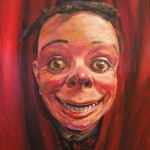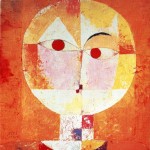Lesson 54
It’s a Joke
As a title ‘It’s a Joke‘ has the capacity to subvert the meaning of any image.
‘It’s a Joke’ is ambivalent, it is contradictory as a statement. It can be taken at face value but the reading is more evidently ironic.
Take any image, a still life, a photo of Margret Thatcher or the Queen, and image of a nuclear bomb, the Houses of Parliament, a map of any country, any image, anything and title it – Its a Joke.
The image will transform and be turned on its head.
‘It’s a Joke’ powerfully says that this is trivial and not worth any interest and that it is also not a joke, that it is serious, that we should be gravely concerned.
There is a dearth of serious investigation into humour, possibly because it is seen as the opposite of seriousness a lowly activity not worth considered attention. G. Wilson Knight said that ‘it is an error of human judgement to regard humour as essentially trivial‘. I am reminded of the story Tony Hancock told, of a man suffering from depression who went to a psychiatrist. The psychiatrist listened sympathetically to the man, and eventually tells the patient to ‘get out of himself‘ and go to the circus where Grock the clown is the toast of the town. The patient simply reveals that he is himself Grock!
Francis Bacon once said that he “always wanted but never succeeded in painting a smile.” It always ended up as a grimace. I like this ambivalence, of an innocent smile that transforms into something ominous. In fact it is this transformation of the joke that interests me.
You can only tell a joke once.
Unlike a singer who can repeat their favourite song, a comedian has to appear original. He cannot keep repeating his jokes if he wishes to continue be funny. A comedian cannot tell you your favourite joke. You have heard it before, although of course you can tell your favourite joke to other people hoping that they have not heard it. My Grandmother, Annie Howarth, was a professional ventriloquist, her stage name being Josephine Langley. She worked on the Music Hall stage from 1911 for 12 years and played all the Moss Empires in Britain including the London Coliseum. During this time she only performed 3 different acts. Today with television and video a performer has to develop new material much more rapidly. A comedian on tour would wait until the end of the tour before the video is released and only then the material of his comedy act might be used on television or radio. If it’s used on television first then that’s it. It’s dead.
However, the joke in a painting stays and has to change. It has to become something ‘other’ if it is to last more than one viewing.
The joke in art has to be able to transform. It has to be able to be told hundreds or thousands of times and get better. The painted joke has to be ambivalent. Paradox is central to this construct.
In Comes I. My painting of Tommy my Mother Insull ventriloquist dummy.
Senecio Paul Klee.1922
This witty painting by Paul Klee has always fascinated and has grown more ominous and disturbing the more I see it and yet it can suddenly return to that innocent quizzical head I first saw as a youth.
One of the most important books for me is Sigmund Freud’s book ‘Jokes, and their relation to the Unconscious‘. ‘Der Witz’ was originally translated as ‘wit’ and then later ‘Jokes’. Wit has a much wider usage in German and English than the word ‘joke’, that of intelligence, innovation and ingenuity. For this reason ‘wit’ seems more applicable to art.
In his book Freud attempted to categorise wit/jokes in a scientific manner, naming categories, like a botanist. Unfortunately his book does not retain much of the humour of the original jokes he uses as examples; it is as if humour is resistant to analytical research.
Seriousness and laughter are closely linked, laughter is a serious business, as any professional comedian would claim, they are not simple opposites. Like beauty and ugliness they are ‘linked with a thousand ties’. One of Freud’s categories is the ‘tendentious’ joke as opposed to the ‘innocent’ joke. Tendentious jokes are jokes with meanings – the blasphemous, obscene, ironic, satirical meaningful joke, adult jokes, in effect serious jokes. These are the jokes of carnival and the vulgar Mr Punch, jokes of change, that debase, bring down in order for a rebirth, jokes that ‘turn the world upside down’. But in carnival we do not insult an individual, carnival is egalitarian, democratic, we insult the body of the people and everyone laughs, no-one is left out, there is no ‘fall guy’.
Death to everyone! Was the cry during Goethe’s Roman Carnival.
Carnival is full of verbal abuses, the wish of death is meant to express joy, good natured mockery and flattery, when familiarity reigns and hierarchical differences are suspended. As Goethe wrote: “Just as in other languages curses and obscene words are often used as expressions of joy or admiration so, on this evening, the true meaning of ‘siaammazzato’ (death to everyone) is completely forgotten, and it becomes a password, a cry of joy, a refrain added to all jokes and compliments”. As Bakhtin has commented, this is “abuse and praise, the death wish and the wish for life in one”. This is where abuse becomes praise, Barry Humphries described Dame Edna’s intrusive insults of her celebrity audience as a form of benediction.
The British ‘alternative’ comedian Ben Elton made a distinction between the jokes told by the prison guards and the jokes the inmates told. This is the political aspect of humour, where context is so important. But in carnival there is one context and all hierarchical differences are suspended, the King become the fool and the fool King. There are no inmates, no guards, everybody is an inmate, everybody lives it and everybody is equal. There is no audience to this spectacle, everybody is a participant.
Bakhtin writes, “the people, the merry host of the earth … knew the death was pregnant with new life and familiar with the notion of ‘becoming’ they responded to verbal and pictorial representation of abuse and death simply as a joke. For the people have a collective understanding of their eternity, of their earthly historic immortality and their continued renewal and growth”.
I said of laughter, It is mad:
and of mirth, What doeth it?
Ecclesiastes 11 V2
The first joke in the Bible was, of course, Kane who said ‘I am not my brothers keeper‘ after killing his brother.
There is a difference between the joke and laughter.
Laughter is an involuntary action, a nervous release, possibly related to the grimace or snarl in animals, fake aggression, a threat, a warning, but animals do not laugh. Laughter is at the very centre of our human nature. In a sense we laugh at all the wrong things, the things that embarrass, that trouble us, the irrational and the taboo, specifically: sexuality, racism, violence, failure, hardship, death and cruelty.
“The pleasure we derive from comedy corresponds to the fulfilment of a basic need – the need to overcome fear, even if only for a moment. Fear of all kinds: terror, superstition, vertigo, our fear of dying, our fear of the unknown, of the leap into the abyss – all the bogeymen which stalk us. The greatest fear is the fear of Death – an enduring and central feature of the comic tradition” Antonio Fava.
Something repressed, forbidden and hidden breaks through into the public arena. Humour makes public the private. It is a juxtaposition of these two separate worlds leaking into one another. We share in laughter the paradoxes and contradictions of our existence. Paradox is the dialectic of life which does justice to life’s injustices.
Jonathan Miller’s comment on laughter as a ‘sabbatical leave from the serious aspects of life‘ would be a good description of carnival, the world upside down. Like the difference between truth and falsehood or imagination and reality. ‘The clown stands on his head and sees the world the right way‘.
Opposites are not opposites. It is irrational. Jokes do not make sense. They transform and are ambivalent.
Jokes happen in your head, they are personal. You ‘get’ the joke. This is what art also does, or at least it parallels some of the claims of conceptual art. As Damien Hirst once said, “with conceptual art, the art is in your head”. I have often compared ‘the joke’ as a structure, as a strategy for the making of art. Certainly humour can make a work accessible.
Lesson 54: make a work of art that makes people laugh, not just muse how witty it is or ingenious and clever you are, but laugh heartily.
This entry was posted on Monday, July 10th, 2017 at 4:25 pm
You can follow any responses to this entry through the RSS 2.0 feed.


